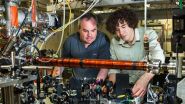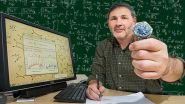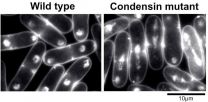Discovery shows what the solar system looked like as a 'toddler'
2015-05-27
(Press-News.org) An international team of astronomers, including researchers from the University of Cambridge, has identified a young planetary system which may aid in understanding how our own solar system formed and developed billions of years ago.
Using the Gemini Planet Imager (GPI) at the Gemini South telescope in Chile, the researchers identified a disc-shaped bright ring of dust around a star only slightly more massive than the sun, located 360 light years away in the Centaurus constellation. The disc is located between about 37 and 55 Astronomical Units (3.4 - 5.1 billion miles) from its host star, which is almost the same distance as the solar system's Kuiper Belt is from the sun. The brightness of the disc, which is due to the starlight reflected by it, is also consistent with a wide range of dust compositions including the silicates and ice present in the Kuiper Belt.
The Kuiper Belt lies just beyond Neptune, and contains thousands of small icy bodies left over from the formation of the solar system more than four billion years ago. These objects range in size from specks of debris dust, all the way up to moon-sized objects like Pluto - which used to be classified as a planet, but has now been reclassified as a dwarf planet.
The star observed in this new study is a member of the massive 10-20 million year-old Scorpius-Centaurus OB association, a region similar to that in which the sun was formed. The disc is not perfectly centred on the star, which is strong indication that it was likely sculpted by one or more unseen planets. By using models of how planets shape a debris disc, the team found that 'eccentric' versions of the giant planets in the outer solar system could explain the observed properties of the ring.
"It's almost like looking at the outer solar system when it was a toddler," said principal investigator Thayne Currie, an astronomer at the Subaru Observatory in Hawaii.
The current theory on the formation of the solar system holds that it originated within a giant molecular cloud of hydrogen, in which clumps of denser material formed. One of these clumps, rotating and collapsing under its own gravitation, formed a flattened spinning disc known as the solar nebula. The sun formed at the hot and dense centre of this disc, while the planets grew by accretion in the cooler outer regions. The Kuiper Belt is believed to be made up of the remnants of this process, so there is a possibility that once the new system develops, it may look remarkably similar to our solar system.
"To be able to directly image planetary birth environments around other stars at orbital distances comparable to the solar system is a major advancement," said Dr Nikku Madhusudhan of Cambridge's Institute of Astronomy, one of the paper's co-authors. "Our discovery of a near-twin of the Kuiper Belt provides direct evidence that the planetary birth environment of the solar system may not be uncommon."
This is the first discovery with the new cutting-edge Gemini instrument. "In just one of our many 50-second exposures we could see what previous instruments failed to see in more than 50 minutes," said Currie.
The star, going by the designation HD 115600, was the first object the research team looked at. "Over the next few years, I'm optimistic that GPI will reveal many more debris discs and young planets. Who knows what strange, new worlds we will find," Currie added.
INFORMATION:
The paper is accepted for publication in The Astrophysical Journal Letters.
ELSE PRESS RELEASES FROM THIS DATE:
2015-05-27
The DNA encoding all life on Earth is made of four building blocks called nucleotides, commonly known as "letters," that line up in pairs and twist into a double helix. Now, two groups of scientists are reporting for the first time that two new nucleotides can do the same thing -- raising the possibility that entirely new proteins could be created for medical uses. Their two studies appear in ACS' Journal of the American Chemical Society.
Synthetic biologists have been attempting for years to expand on nature's genetic "alphabet," consisting of the nucleotide bases cytosine, ...
2015-05-27
With summer nearly here, U.S. consumers might think they have an abundance of sunscreen products to choose from. But across the Atlantic, Europeans will be slathering on formulations that manufacturers say provide better protection against the sun's damaging rays -- and skin cancer -- than what's available stateside, according to an article in Chemical & Engineering News (C&EN), the weekly newsmagazine of the American Chemical Society.
Marc S. Reisch, a senior correspondent at C&EN, reports that sunscreens on the U.S. market do protect users from some ultraviolet-A and ...
2015-05-27
Patients treated for an acute respiratory infection by a doctor on a telephone or live video are as likely to be prescribed an antibiotic as patients who are treated by a physician face-to-face for the same illness, according to a new RAND Corporation study.
However, the patients treated virtually were more likely to be prescribed a broad-spectrum antibiotic -- concerning since overuse of the drugs increases costs and contributes to antibiotic resistance, according to the study.
Researchers say both treatment settings had high rates of inappropriate prescribing for ...
2015-05-27
Some children with autism should undergo ongoing screenings for apraxia, a rare neurological speech disorder, because the two conditions often go hand-in-hand, according to Penn State College of Medicine researchers.
Over the course of a three-year study, 64 percent of children initially diagnosed with autism were found to also have apraxia. The study also showed that the commonly used Checklist for Autism Spectrum Disorder (CASD) accurately diagnoses autism in children with apraxia.
"Children with apraxia have difficulty coordinating the use of their tongue, lips, ...
2015-05-27
The bizarre nature of reality as laid out by quantum theory has survived another test, with scientists performing a famous experiment and proving that reality does not exist until it is measured.
Physicists at The Australian National University (ANU) have conducted John Wheeler's delayed-choice thought experiment, which involves a moving object that is given the choice to act like a particle or a wave. Wheeler's experiment then asks - at which point does the object decide?
Common sense says the object is either wave-like or particle-like, independent of how we measure ...
2015-05-27
An international team of scientists studying ultrafast physics have solved a mystery of quantum mechanics, and found that quantum tunneling is an instantaneous process.
The new theory could lead to faster and smaller electronic components, for which quantum tunneling is a significant factor. It will also lead to a better understanding of diverse areas such as electron microscopy, nuclear fusion and DNA mutations.
"Timescales this short have never been explored before. It's an entirely new world," said one of the international team, Professor Anatoli Kheifets, from The ...
2015-05-27
This news release is available in Japanese.
Right before a cell starts to divide to give birth to a daughter cell, its biochemical machinery unwinds the chromosomes and copies the millions of protein sequences comprising the cell's DNA, which is packaged along the length of the each chromosomal strand. These copied sequences also need to be put back together before the two cells are pulled apart. Mistakes can lead to genetic defects or cancerous mutations in future cell generations.
Just like raising a building requires scaffolding be erected first, cells ...
2015-05-27
The method used to calculate Standard & Poor's Case-Shiller Home Price Indices, the most trusted benchmark for U.S. residential real estate prices, contains a flaw that likely could lead to misstating its monthly estimates, according to a newly published study led by faculty at Florida Atlantic University.
The paper published in the Journal of Real Estate Research identifies an important deficiency in the Weighted Repeated Sales (WRS) method developed by economists Karl Case and Robert Shiller, which compares repeat sales of the same homes in an effort to study home ...
2015-05-27
Anti-osteoporotic medication is not an effective means for preventing hip fractures among the elderly, concludes a study recently published in the BMJ.
Proximal femoral fractures (i.e., hip fractures) occur in the world at a rate of 1.5 million per year, or 7,000 per year in Finland. As most such fractures occur among older people, their number is expected to grow as the population ages. Hip fractures often lead to permanently reduced mobility, quality of life and general health, as well as result in significant social costs.
Since the early 1990s, anti-osteoporotic ...
2015-05-27
The teacher's interaction style can either foster or slow down the development of math skills among children with challenging temperaments. This was shown in the results of the study "Parents, teachers and children's learning" carried out at the University of Jyväskylä, Finland.
Ph.D. Jaana Viljaranta, along with her colleagues, studied the role of teachers' interaction styles in academic skill development among children with different temperamental characteristics.
A child's challenging temperament may show up in the classroom, for example, as low task-orientation ...
LAST 30 PRESS RELEASES:
[Press-News.org] Discovery shows what the solar system looked like as a 'toddler'


